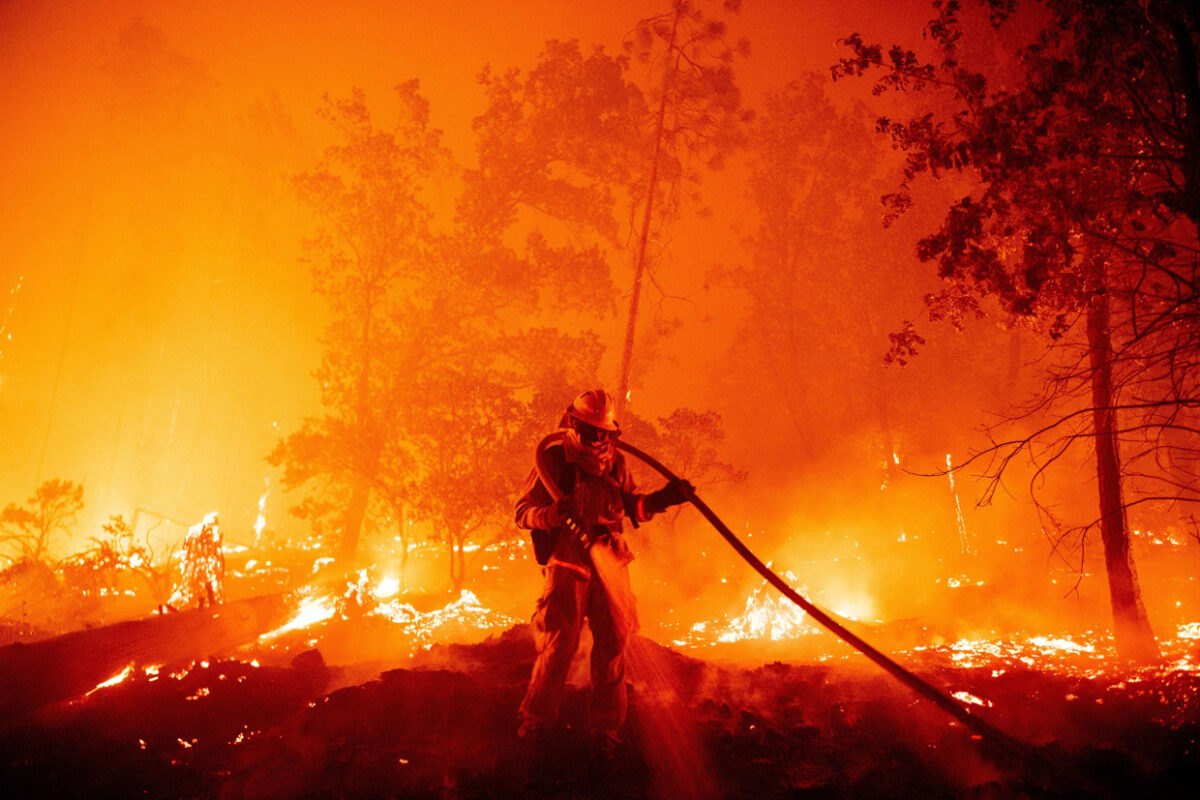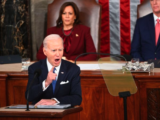
A firefighter douses flames as they push towards homes during the Creek fire in the Cascadel Woods area of unincorporated Madera County, Calif.: Josh Edelson
Staff Report –
WASHINGTON, D.C. — To reduce the threat of wildfires in the American West, the Biden administration announced new spending measures this week through the Department of Agriculture to improve forest health and reduce fuel for fires by the U.S. Forest Service.
Agriculture Secretary Tom Vilsack announced expanded efforts to reduce wildfire risk across the western U.S., investments made possible through President Biden’s landmark Bipartisan Infrastructure Law (BIL) and the Inflation Reduction Act (IRA). The plan involves directly protecting at-risk communities and critical infrastructure across 11 landscapes in Arizona, California, Idaho, Nevada, Oregon, Utah and Washington.
“It is no longer a matter of if a wildfire will threaten many western communities in these landscapes, it is a matter of when,” Secretary Vilsack said. “The need to invest more and to move quickly is apparent.
“This is a crisis and President Biden is treating it as one,” he said.
More than $490 million will be allocated to 11 key landscapes and used to restore national forests, including old-growth forests.
The Forest Service announced their original 10 landscape project areas last year as part of the agency’s broader strategy to protect communities, critical infrastructure and forest resources from catastrophic wildfires. Combined with these initial landscape investments, the additional efforts being announced represent a total USDA investment of $930 million across 45 million acres.
This work spans 134 of the 250 high-risk “firesheds” identified in the Wildfire Crisis Strategy plan and will mitigate wildfire risk to around 200 community firesheds in areas where wildfire is likely to pose the greatest risk to communities and national resources. The landscapes for these additional investments were selected based on the potential for wildfire to affect nearby communities and buildings, with a focus on protecting underserved communities, critical infrastructure, public water sources and Tribal lands.
The agency considered more than 3,000 comments from 11 roundtable meetings held in the first half of 2022, which included partners, industry, Tribes and other stakeholders.
“We are building on the investments announced last year and by expanding the Forest Service effort to cover 21 landscapes where communities, critical infrastructure and our natural resources are most in need of protection from the growing threat of wildfires,” said Dr. Homer Wilkes, USDA Undersecretary for Natural Resources and the Environment. “This is part of our agency wide focus to reduce wildfire risk across the country. We will use every tool we have to address this crisis and make your communities safer.”
Secretary Vilsack is also directing the Forest Service to use and prioritize a suite of provisions authorized in the Bipartisan Infrastructure Law to more quickly apply targeted treatments to the high-risk firesheds, while opening up additional opportunities to pursue science-based reforestation and restoration of old growth forests.
These treatments are required to be ecologically appropriate, maximize the retention of large trees, protect old growth, and to consider possible effects on historically underserved communities and Tribes. Treatments are also to be carried out collaboratively alongside participating communities and partners.
“Doing this work in the right place, at the right time, and at the right scale, combined with the use of emergency authorities, will accelerate our planning, consultation, contracting, hiring and project work to reduce wildfire risk and improve forest health and resilience,” Forest Service Chief Randy Moore said. “Collaboration with Tribes, communities and partners will remain a priority, and we will continue to use the best available science when carrying out this important work.”
Background: The Forest Service Wildfire Crisis Strategy
This announcement comes on the anniversary of the launch of the Forest Service’s Wildfire Crisis Strategy, which debuted Jan. 18, 2022. A few months later, the agency introduced the initial 10 fire-prone landscapes that are now funded for the next five years through Bipartisan Infrastructure Law funds. In addition, President Biden’s Inflation Reduction Act will commit $1.8 billion to hazardous fuels reduction projects on national forests and grasslands.
Since releasing its Wildfire Crisis Strategy one year ago, the Forest Service and its partners have used the best available science and data to identify the highest risk landscapes for treatment projects. The Forest Service found that around 80 percent of the wildfire risk to communities is concentrated in less than 10 percent of firesheds. These targeted investments focus on firesheds of the highest risk, where projects are ready to begin or to expand.
The 10-year strategy calls for treating up to 20 million acres on national forests and grasslands and up to 30 million acres on other federal, state, Tribal, private and family lands to assure forests are more resilient to wildfire and other effects of climate change, safer for communities, and remain key refuges for plants, fish and wildlife.
Over the past 20 years, many states have had record catastrophic wildfires, devastating communities, lives and livelihoods, and causing billions of dollars in damage. More than 10 million acres – more than twice the size of New Jersey – burned each year across the U.S. in 2020, 2017 and 2015.
The strategy builds on current work by leveraging congressional authorities and partnerships to support the department’s work to mitigate wildfire risk, and restores forest health over the next decade. In addition to State Forest Action Plans, the strategy also aligns with the Collaborative Forest Landscape Restoration Program, Tribal Forest Protection Act, Good Neighbor Authority, Joint Chiefs’ Landscape Restoration Partnership and Shared Stewardship agreements.
In June 2022, USDA released the Secretary’s Memorandum on Climate Resilience and Carbon Stewardship of America’s National Forests and Grasslands. The Secretary’s memo builds on previous actions on climate change, equity, and forest resilience, and provides more specific and time-bound actions to integrate into agency programs. The Forest Service used the guidance in the Secretary’s memo to better inform the selection criteria for projects under the Wildfire Crisis Strategy, including equity, source water protection, community infrastructure and wildlife corridors.
Recognizing that insects, disease, and wildfire are among the most significant threats to mature and old growth forests, in alignment with the Biden Administration, the Forest Service will be targeting hazardous fuels reduction projects to address these threats to promote the protection and restoration of mature or old-growth forests.
To learn more, visit the U.S. Department of Agriculture online
___
If you support truth in reporting with no paywall, and fearless writing with no popup ads or sponsored content, consider making a contribution today with GoFundMe or Patreon or PayPal.
Before you continue, I’d like to ask if you could support our independent journalism as we head into one of the most critical news periods of our time in 2024.
The New American Journal is deeply dedicated to uncovering the escalating threats to our democracy and holding those in power accountable. With a turbulent presidential race and the possibility of an even more extreme Trump presidency on the horizon, the need for independent, credible journalism that emphasizes the importance of the upcoming election for our nation and planet has never been greater.
However, a small group of billionaire owners control a significant portion of the information that reaches the public. We are different. We don’t have a billionaire owner or shareholders. Our journalism is created to serve the public interest, not to generate profit. Unlike much of the U.S. media, which often falls into the trap of false equivalence in the name of neutrality, we strive to highlight the lies of powerful individuals and institutions, showing how misinformation and demagoguery can harm democracy.
Our journalists provide context, investigate, and bring to light the critical stories of our time, from election integrity threats to the worsening climate crisis and complex international conflicts. As a news organization with a strong voice, we offer a unique, outsider perspective that is often missing in American media.
Thanks to our unique reader-supported model, you can access the New American journal without encountering a paywall. This is possible because of readers like you. Your support keeps us independent, free from external influences, and accessible to everyone, regardless of their ability to pay for news.
Please help if you can.
American journalists need your help more than ever as forces amass against the free press and democracy itself. We must not let the crypto-fascists and the AI bots take over.
See the latest GoFundMe campaign here.
Don't forget to listen to the new song and video.
Just because we are not featured on cable TV news talk shows, or TikTok videos, does not mean we are not getting out there in search engines and social media sites. We consistently get over a million hits a month.
Click to Advertise Here














